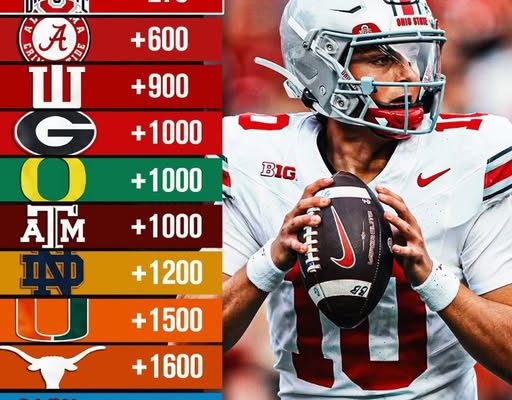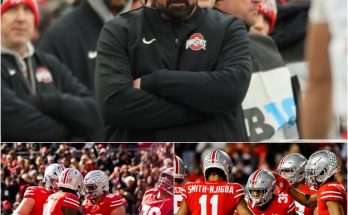In the ever-churning, opinion-rich waters of college football, where every Saturday brings a new potential earthquake and every Sunday a fresh set of seismic readings, there exists a rare and telling phenomenon: consensus. It is fleeting, fragile, and often illusory, but when a critical mass of media pundits, analytical models, and, most significantly, the cold, hard calculus of the betting market all point in the same direction, it demands attention. As we navigate the early chapters of the season, that very consensus has crystallized around a single, formidable entity: The Ohio State University. Despite a summer of change, on-field challenges that have prompted scrutiny, and a landscape rife with other compelling contenders, the Buckeyes have, according to the latest odds from BetMGM and other major sportsbooks, not only held their ground but have reaffirmed their position as the definitive favorite to win the College Football National Championship.
This sustained confidence is fascinating precisely because it is not born from a season of dominant, wire-to-wire blowouts. Ohio State’s path through the first half of its schedule has been more of a gritty, defensive-minded grind than the offensive fireworks display many have come to expect from Columbus. The offense, under new starting quarterback Kyle McCord, has shown flashes of its potential brilliance, particularly with the nation’s most gifted receiver, Marvin Harrison Jr., making the spectacular look routine. Yet, it has also displayed moments of disconcerting inconsistency, with protection issues and a running game that has yet to find its fearsome, perennial rhythm. The victory over a stubborn Notre Dame team was a testament to resilience and clutch play-calling, but it was a nail-biting, final-second affair, not a statement demolition. So why, then, does the market remain so steadfast in its belief?
The answer lies in a multifaceted evaluation that transcends weekly box scores. Firstly, and perhaps most importantly, is the sheer, unassailable accumulation of talent on the roster. Head coach Ryan Day and his staff have been recruiting at a level surpassed by no one, and the dividends are paying off in a depth chart that is the envy of the nation. This is not a team reliant on one or two superstars. While Harrison Jr. is a generational talent, the Buckeyes are stocked with former five-star recruits and future high-round NFL draft picks at nearly every position. This depth becomes the critical differentiator in a long season defined by attrition. When a key player goes down, Ohio State doesn’t plug in a replacement; they slot in another blue-chip athlete who would be a star on almost any other team in the country. This built-in resilience is a luxury few programs can claim and is a primary factor in their ability to navigate a 12-game schedule and a potential conference championship with their championship aspirations intact.
Secondly, the identity of this year’s Ohio State team has undergone a profound and, from a championship perspective, perhaps a necessary transformation. For years, the Buckeyes were synonymous with offensive pyrotechnics, outscoring opponents in high-flying shootouts. The defense, while often solid, was at times the subject of criticism, especially in high-stakes games against elite opponents. This year, the script has been flipped. Under the guidance of defensive coordinator Jim Knowles, the Buckeye defense has evolved from a supporting cast into the leading act. They are faster, more physical, and fundamentally sounder. They are generating pressure with their front four, their linebackers are flying to the football with purpose, and the secondary, led by Denzel Burke, has been lockdown. In a sport where championships are so often won with defensive stops, this new identity is not a weakness but a strategic asset. It suggests that even on a day when the offense sputters, as it did for stretches against Notre Dame and Penn State, Ohio State possesses the defensive prowess to keep them in the game and give them a chance to win. This balance makes them a more complete, and therefore more dangerous, team than in years past.
Of course, the landscape of college football is not a vacuum, and Ohio State’s position at the top is also a reflection of the perceived vulnerabilities of their primary competitors. The Georgia Bulldogs, the two-time defending champions, were the pre-season co-favorites but have since seen their odds drift slightly. The reason is evident: while they remain undefeated, they have not looked like the indomitable force of the past two seasons. Their defense, while still very good, has shown cracks, and close calls against unranked opponents like Auburn and South Carolina have introduced a sliver of doubt into the market’s mind. The aura of invincibility has, for the moment, faded. Similarly, the Michigan Wolverines, despite their own dominant start and impressive running game, are navigating the dual distractions of an ongoing NCAA investigation and a schedule that has been, to put it mildly, forgiving. The market is seemingly taking a “wait-and-see” approach with the Wolverines, questioning whether their early-season form will translate against the gauntlet they will eventually face.
Further down the list, other contenders present compelling cases but with clear caveats. The Florida State Seminoles have a thrilling offense and a statement win over LSU, but questions about their defensive consistency and the overall strength of the ACC linger. The Washington Huskies boast perhaps the most explosive passing attack in the nation with Michael Penix Jr., but their path through the Pac-12 is a minefield of offensive juggernauts, and their defense has yet to be truly tested by a team of Ohio State’s caliber. The Oklahoma Sooners and Texas Longhorns have both looked impressive, but both are also only a year removed from less-stellar seasons and are proving their mettle in real-time. In this context of uncertainty surrounding every other elite team, Ohio State’s “flaw” – an offense still finding its ultimate rhythm – is viewed as a solvable problem rather than a fatal flaw. The market is betting on Day’s offensive acumen, the growth of McCord, and the sheer talent at the skill positions to coalesce into a dominant unit by season’s end.
The road ahead, however, is far from clear. The Big Ten East remains a brutal division, and the final stretch of the season will be a defining crucible. The upcoming clash with a resurgent Penn State, followed by the monumental, season-ending showdown with Michigan in Ann Arbor, represents a two-game stretch that could make or break their championship dreams. These are not just games; they are cultural events, rivalry contests where records are thrown out the window and emotion can be the great equalizer. To emerge from that gauntlet unscathed requires not just talent, but immense mental fortitude, coaching excellence, and a little bit of luck.
Ultimately, the betting odds are not a prediction of who will win each individual game, but a probabilistic assessment of who is most likely to be the last team standing in Houston come January. They are a distillation of countless data points, from advanced analytics and roster composition to coaching track records and the intangible quality of “game control.” In this complex equation, Ohio State currently presents the most compelling package. They have the best overall roster, a defense that has proven it can win games, an offense with a ceiling that is terrifyingly high, and a schedule that, while difficult, provides them with the high-quality wins the College Football Playoff committee craves. The market is making a calculated wager that the Buckeyes’ early-season struggles were the growing pains of a team learning to win in a new way, and that as the stakes get higher, their talent and newfound defensive identity will carry them through. In Columbus, the standard is not just to compete, but to win championships. This year, more than any in recent memory, the entire ecosystem of college football believes they are built to do just that. The target is firmly on their back, and the world is watching to see if they can bear the weight of expectation all the way to the summit.



